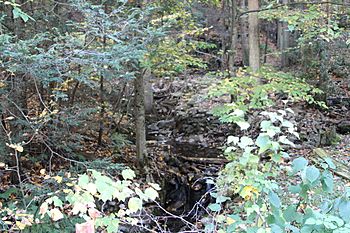Cranberry Run facts for kids
Quick facts for kids Cranberry Run |
|
|---|---|

Cranberry Run in its lower reaches
|
|
| Physical characteristics | |
| Main source | Catawissa Mountain in Beaver Township, Columbia County, Pennsylvania 1,660 ft (510 m) |
| River mouth | Catawissa Creek in Beaver Township, Columbia County, Pennsylvania 754 ft (230 m) 40°55′13″N 76°15′19″W / 40.9204°N 76.2553°W |
| Length | 2.0 mi (3.2 km) |
| Basin features | |
| Progression | Catawissa Creek → Susquehanna River → Chesapeake Bay |
| Basin size | 1.83 sq mi (4.7 km2) |
Cranberry Run is a small stream in Columbia County, Pennsylvania. It flows into Catawissa Creek. The stream is about 2.0 miles (3.2 km) long. It flows through Beaver Township. The area of land that drains into Cranberry Run is 1.83 square miles (4.7 km2). This stream is known as a Coldwater Fishery.
Contents
Where Cranberry Run Flows
Cranberry Run starts on Catawissa Mountain in Beaver Township. It flows towards the northeast through a valley for more than a mile. It flows close to the border between Columbia and Schuylkill Counties.
The stream then turns mostly north. It crosses Bunker Hill Road. It flows between Catawissa Mountain and Bunker Hill. After crossing Cranberry Run Road, it turns northeast again. A short distance later, it joins Catawissa Creek. Cranberry Run meets Catawissa Creek about 18.57 miles (29.89 km) before Catawissa Creek reaches its own end.
No Tributaries Here
Cranberry Run does not have any smaller streams or "tributaries" flowing into it.
Water Quality of Cranberry Run
About 2.0 miles (3.2 km) of Cranberry Run's length is affected by pollution. This pollution makes the water too acidic. The stream is very acidic, likely because of acid rain. Its pH level is 5.8, which is quite acidic. It has no alkalinity, which helps balance acidity.
The natural cranberry bogs at the start of the stream might also make the water more acidic. The water in Cranberry Run is also very soft.
Scientists measured the water temperature at 13.3°C (56°F) on a summer day. The air temperature nearby was 19°C (66°F). The stream's specific conductance, which shows how well water conducts electricity, is 22 umhos.
Land and Rocks Around the Stream
The land near where Cranberry Run joins Catawissa Creek is about 754 feet (230 m) above sea level. The stream starts much higher, at about 1,660 feet (510 m) above sea level.
The lower parts of Cranberry Run flow over rocks from the Mauch Chunk Formation. The upper parts of the stream are on rocks from the Pocono Formation. The soil near the lower stream is called Leck Kill soil. The rest of the stream flows over Hazleton soil.
A small hill called Bunker Hill is close to Cranberry Run. Catawissa Mountain is also nearby. Not many areas along the stream are likely to flood. Cranberry Run drops quickly, about 86.8 meters for every kilometer it flows. It is also a small stream, only about 2.7 meters wide.
The Cranberry Run Area
The area of land that drains into Cranberry Run is 1.83 square miles (4.7 km2). Most of this area is in Beaver Township, Columbia County. A small part is in Roaring Creek Township, Columbia County. A larger part is in North Union Township, Schuylkill County.
The stream's starting point is in Pennsylvania State Game Lands Number 58. Some other parts of the stream are also in this game land. Most of the land in the watershed is covered by forests. However, there is some farmland in the lower parts of the watershed.
About 10 percent of Cranberry Run's length is within 100 meters of a road. In 1990, about 10 people lived in each square kilometer of the watershed. Cranberry Run is very close to Klingermans Run. Both streams have similar types of rocks and land uses. Cranberry Run is located in the Shumans area on United States Geological Survey maps.
Why "Cranberry Run"?
Cranberry Run got its name because it is near a marsh. Also, cranberries used to grow near the stream a long time ago.
Animals and Plants
The Pennsylvania Department of Environmental Protection considers Cranberry Run a coldwater fishery. This means it should be a good place for fish that like cold water. However, no fish have been seen in the stream. The water is too acidic for fish to live there, likely because of acid rain. Wild brook trout used to live in the stream a long time ago.
There are natural cranberry bogs where Cranberry Run begins. These are wet, marshy areas where cranberries grow.

